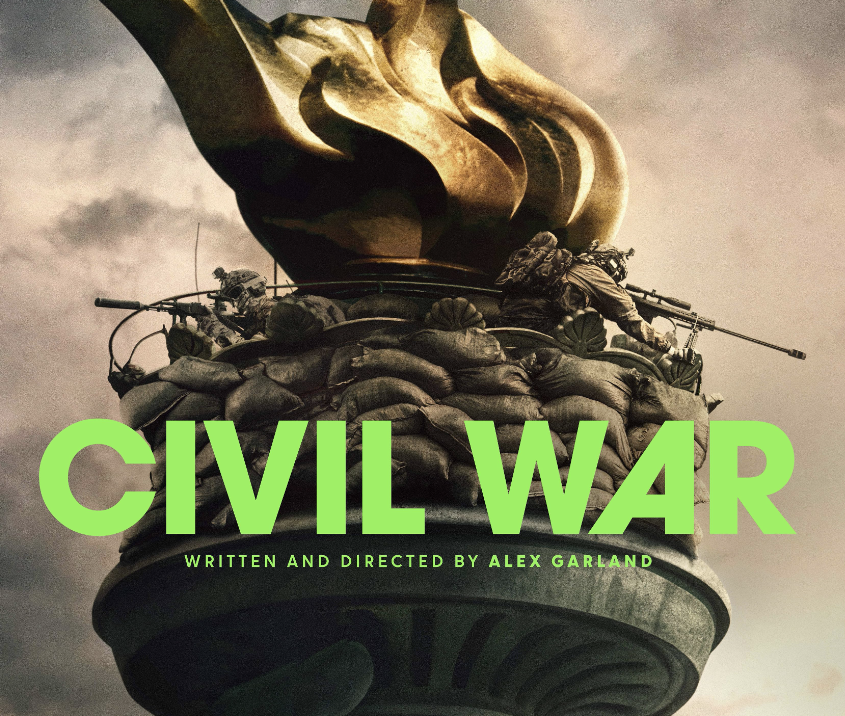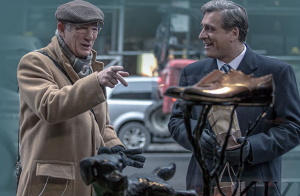Content Warning: This article contains brief descriptions of warfare and political violence
Most Americans have the immense privilege of not knowing what war looks like. They can read every novel, see every documentary, and watch every live television broadcast, but truthfully, they could never imagine what all-out warfare looks like from a first-hand perspective. For the most apathetic Americans, that kind of violence is relegated to thousands of miles away in countries they never plan on visiting—far from their studio apartments and white picket fences.
Written and directed by Alex Garland, Civil War (2024) imagines a dystopian future America where the United States has descended into a devastating interstate conflict. Spurned by the President’s (Nick Offerman) descent into fascism, states like California, Texas, and Florida have seceded from the Union and pledged to overthrow the despotic American government. Following a crew of journalists traveling to Washington D.C.to report on the government’s fall to the fictional Western Forces (WF), the film follows their journey through a land ravaged by political violence and the breakdown of law as they attempt to document it.
When Civil War’s trailer first dropped, the film faced a healthy amount of skepticism for its marketing as a grim prediction of the nation’s future amid the normalization of political violence and events like the January 6 Insurrection. Dissenters questioned whether dramatizing America’s polarization to such an extreme would do more harm than good. Frankly, the film’s marketing has sown the seeds for critical misinterpretation: audiences who expect a firm denunciation of today’s heated political climate won’t be satisfied with Garland’s choice to depict a fractured America from a relatively neutral lens. Yet, for those who enter the theater with their preconceived notions set aside, Civil War represents a visual and sonic marvel that forces American audiences to grapple with the horror of modern warfare brought to U.S. shores.
Undoubtedly, the film inspires awe through its strikingly graphic depictions of death and destruction across the urban, suburban, and rural landscapes of America. Scenes of mundane life brought to ruin provoke the same visceral reactions as scenes of extreme bloodshed; images of automobile carcasses littering interstate highways and refugee camps in football stadiums feel just as jarring as footage of civilians torturing one another. At times, Civil War’s terrifying cinematography makes it feel like a horror film—no doubt a product of the director’s horror-dominated filmography. Garland’s catalog has clearly provided him with the experience necessary to provoke outrage, fear, and despair with a singular camera shot.
Another stylistic triumph of the film is its sound design, which becomes restrained when necessary while remaining incredibly pointed. Multiple scenes in Civil War underscore Lee’s (Kirsten Dunst) and Jessie’s (Cailee Spaeney) photographs of the unfolding chaos with complete silence. The lack of sound combined with pictures of carnage forces the audience to absorb the gravity of the situation. On the other hand, transitions between scenes are often soundtracked with classic American rock and hip-hop, reminding U.S. viewers that the tragic world they are looking at is hauntingly close to the one they are living in.
A common criticism of Civil War is that its extremely graphic images might glorify the very political violence the film seeks to denounce. As with many war films, bloodthirsty consumers can always derive their own hawkish lessons by revering warmongering characters rather than renouncing them. Yet Civil War’s brutality is why it works—it becomes difficult to revere any of these fighters considering their use of suicide bombings and mass graves. These scenes are horrifying to watch, but that’s the point. Wars breed scenes of wanton slaughter and innocent life lost every day—experiencing this violence from the safety of a reclining theater seat is a privilege many people do not enjoy. To omit the graphic nature from Civil War would sanitize the viewing experience, leaving audiences complacent and comfortable in their privilege.
Garland makes the protagonists of Civil War journalists to implore the need for objective press during war. Lee and Jessie’s work capturing the war through a camera lens appalls the audience, as the subjects of their photographs are seen gleefully butchering fellow countrymen while happily posing for the photographers, proud of their deluded display of patriotism. Yet, without the work of Lee and Jessie, future generations risk forgetting about all those lost in the frenzy of overthrowing the government. This fact is perhaps best represented with Lee’s admonition that if she were to die in this war—an all too real possibility—then Jessie better be ready to photograph it.
Despite their protected status as press, Lee, Jessie, Joel (Wagner Moura), and Sammy (Stephen McKinley Henderson) often find their lives imperiled by their own hands or the hands of ruthless soldiers. This constant danger produces a tension present throughout the entire film, heightened intensely when the protagonists find themselves in the midst of a fire fight or at the end of a rogue gun barrel. The actors’ phenomenal work humanizing the characters makes it hard to watch them risk everything, and yet, their close-up reporting is priceless. The audience must face the grim reality that accurately recording war often comes at the cost of many journalists’ lives.
For all its triumphs, Civil War certainly falters at times. The dialogue occasionally fumbles, especially when it veers into clumsy commentary on America’s current ideological rifts. The fierce commitment to removing political parties and ideologies from the film detracts from its conviction and might leave audiences wanting more, especially if they’re expecting Garland to make biting critiques.
That being said, Civil War is incredibly effective at compelling audiences to imagine what 21st century warfare—with all its bloodshed, suffering, and injustice—would look like on U.S. soil. Most American audiences have the privilege of cognitive dissonance about war given the last one fought on U.S. soil ended over 150 years ago. It’s easy to ignore—or worse, cheer on—acts of mass violence when they’re happening in Southeast Asia, Africa, or the Middle East, but not so much when they’re occuring in Pennsylvania or West Virginia.
There’s a scene around the midway point of the film where the protagonists happen upon a quaint suburban town which seems extraordinarily unaffected by the ongoing civil conflict. When Joel questions a store cashier about their situation, she dully responds that they “just try to stay out.” The real-life metaphor is painfully obvious—Americans tend to cover their eyes and act like there isn’t war and death happening around the world. It’s evident Garland resents this facet of American culture, and so Civil War is his attempt to get American audiences to wake up and do something.
Civil wars are not glorious—they are brutal, gruesome, and terrifying. The U.S. had its own, and, until the Vietnam War, the American military losses from that conflict exceeded the losses from all other American wars combined. Though it may be somewhat dramatic, Civil War paints a haunting picture of what the U.S. could be reduced to if its political divides were to lead citizens to turn on one another. It is uncomfortable and shocking, but that shock factor is necessary in persuading Americans to take its messages seriously. For a film that has the potential to be wildly tone-deaf and out-of-pocket, Civil War proves to be much more impressive and striking than its premise may let on.





